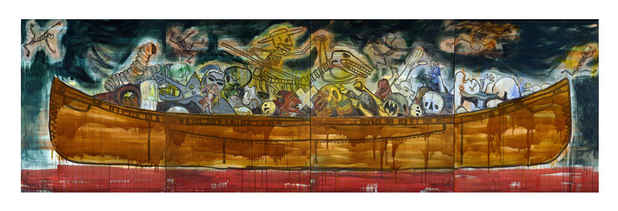“Women Only” Exhibition
Flomenhaft

This event has ended.
From 2006 through 2008, an exhibition entitled Women Only curated by Eleanor Flomenhaft, owner of Flomenhaft Gallery in Chelsea, traveled to eight museums in California, Texas, Indiana, West Virginia and Florida. Twenty artists were included: Amalia Mesa-Bains, Jennifer Bartlett, Camille Billops, Elizabeth Catlett, Linda Freeman, Ann Hamilton, Grace Hartigan, Jenny Holzer, Barbara Kruger, Elizabeth Murray, Hawardena Pindell, Faith Ringgold, Miriam Schapiro, Laurie Simmons, Jaune Quick-to-see Smith, Joan Snyder, Pat Steir, Gail Tremblay, Jackie Winsor and Flo Oy Wong.
The exhibition never came to New York and many artists have asked Flomenhaft to do another exhibit with the same theme. Thus, the decision was made to do a series of Women Only exhibits this time at the gallery instead of for museums. Two artists, Faith Ringgold and Jaune Quick-to-See Smith, who were in the original exhibit come together with three artists whose works add new energy, Emma Amos, Mira Lehr, and Carrie Mae Weems, for the first exhibition of the series.
Emma Amos says about her art: “Many of my paintings, prints, and photographic installations mean to connect more than one form of knowledge or experience with the images within the work. I hope the subjects of my paintings dislodge, question, and tweak prejudices and notions relating to art and who makes it, poses for it, shows it, and buys it. The work reflects my investigations into the otherness often seen by white male artists, along with the notion of desire, the dark body versus the white body, racism, and my wish to provoke more thoughtful ways of thinking and seeing.”
Faith Ringgold, painter, writer, and mixed media sculptor is recipient of more than 75 awards including 22 Honorary Doctor of Fine Arts. She was greatly influenced by the fabric she worked with at home with her mother, Willi Posey, a fashion designer, and Ringgold has used fabric in many of her artworks. She is especially well known for her painted story quilts, which blur the line between “high art” and “craft” by combining painting, quilted fabric and storytelling. Ringgold and Lucy Lippard worked together in the group Women Artists in Revolution (WAR.) Ringgold and her daughter, the writer Michele Wallace, founded Women Students and Artists for Black Art Liberation (WSABAL.) She has written and illustrated seventeen children’s books. The first, Tar Beach, won the Coretta Scott King Award for Illustration and the Ezra Jack Keats New Writer Award.
As a young artist, Mira Lehr was at the forefront of abstract expressionism and had much to do with mobilizing the female voice in Miami. There she co-founded the Continuum Gallery, the first women’s co-op in the southeast. In 1969, Lehr was selected to be a participant with Buckminster Fuller on the first World Game Scenario Project at the New York Studio School. Her work encompasses painting, design, sculpture and video installations. Processes include non-traditional media such as resin, gunpowder, fire, Japanese paper, dyes and welded steel. Lehr says of her art: “The tenuous balance between the abstract and the illusion, the hidden and the revealed, and the hard edge and the soft focus, all add to the mystery and range of emotional resonance of the work.” Lehr’s passion is to observe nature and reorganize its complexity into a higher order. The new universe that she creates becomes more powerful than the reality that inspires it.
Jaune Quick-to-See Smith is from the Salish & Kootenai tribes in Western Montana. She often compares Native America to the Judaic experience. “Like the holocaust that occurred in Europe, there were millions here that were exterminated in the Americas. The estimate of how many were here when Columbus came run as high as one hundred million although our history books often say something like eight to ten million. Another reason Native America and the Judaic experience have so much in common is that for so long we had to hide our religion and our languages to deal with the dominant culture. It is like the Jewish people in Spain having to go to the cellar to pray. But my art is not about my hate aimed at the government. It’s about the government’s hate aimed towards us.”
In 1989 and 1990 photographer Carrie Mae Weems created a series which celebrated the range of skin color hidden behind the term “black.” The triptychs and single image in the “Black” series portray the way the African American community has created its own hierarchy of color. The Sea Island Series which incorporates photos and superstitions of the Gullah people was done between 1991 and 1992. Weems was interested in the Sea Islands of South Carolina and Northern Georgia since her coursework in the 1980s with Dr. Lydia Parrish, a Berkeley folklorist famous for her studies on St. Helena in the Georgia Sea islands. The Gullah people were originally slaves who came to this country from different communities on the Rice Coast off western Africa. Their language was made up of English and approximately 4000 words from different African languages.
[Image: Jaune Quick-to-See Smith “Trade Canoe: Don Quixote in Sumeria” 2005, Oil and Acrylic on Canvas, 60 x 200 in.]
Media
Schedule
from January 09, 2014 to February 22, 2014
Opening Reception on 2014-01-23 from 18:00 to 20:00